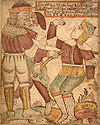- N-rule
-
-
-
- For the typographic term "n-rule" or "n-dash" see Dash
-
In Icelandic orthography, the N-rule dictates whether or not one or two n’s should be written, sometimes affecting pronunciation.
Contents
Compound words
The second n in a compound word goes after the first compounded word. For example:
- Þessi mynd er kynngi mögnuð! (of the word kunnugur)
- Skálinn okkar er kyngifenntur. (of the word kyngja)
It can often be hard to find related words to prove whether one or two n’s should be written, and if all fails, one can try to eliminate options until the most likely one has been found. The best way is to look up words with two n’s in their stem. If no such words are to be found, the use of one n is practical.
For example:
- Elísu vantar krans.
Function words
Below are rules about the number of n’s in function words, which do not decline nor conjugate. Various function words which indicate movement end on –an and never –ann.
Examples:
- Hvaðan, austan, vestan, sunnan, norðan, innan, utan, ofan, neðan, framan, aftan, handan, undan, héðan, þaðan, meðan, áðan, saman, síðan, jafnan, jafnharðan, sjaldan.
Adverbs
In the adverbs “þanneiginn” (þann + veginn) and “hinseginn” two n’s are written.
Enn and en
One is supposed to write “enn” - meaning "still" - whenever it's possible to use “enn þá” instead without changing the meaning of the sentence. In every other case, “en” is used. “En”, which can mean different things, is often used when comparing. “En” can also be a conjunction.
Examples for two n:
- Ég er enn ungur og myndarlegur. - "I'm “still” young and beautiful"
- Ég er enn þá ungur og myndarlegur.
- Ertu enn skólastjóri? - "Are you still headmaster of the school?"
- Ertu enn þá skólastýra?
Examples for one n:
- Stúlkan er hærri en pilturinn. - "The guy is taller “than” the girl"
- Er blár fallegri litur en rauður? "Is blue a more beautiful colour “than” red?"
- “En” hvað finnst þér? "“And” what do you think?"
- Ég vildi bláan bíl en hún vildi rauðan." "I wanted a blue car, “but” she wanted a red one."
Definite article
The definite article always uses the same number of "n" which means that it doesn't matter whether it's added as a suffix to the word or written as a separate word.
Example:
- Separate word: Hin skemmtilega kona. - "The funny woman"
- Suffixed: Skemmtilega konan.
Example:
- Separate word: Hinn hávaxni maður. - "The tall man"
- Suffixed: Hávaxni maðurinn.
Two "n" are used whenever a possessive pronoun has got "i" (minni, minnar, minn, minna..).
One "n" is used whenever a possessive pronoun has got' 'í' (mínum, míns, mína, mín..).
The number of "n" in a possessive pronoun always corresponds to the number of "n" of the definite article of the same form:
Example:
- Hesturinn. → Minn hestur. - "The horse" → "My horse" (Nom. Sg. Masc.)
- Hestinum. → Mínum hesti. - "To the horse" → "To my horse" (Dat. Sg. Masc.)
- Ákvarðananna. → Minna ákvarðana. - "Of the choices" → "Of my choices" (Gen. Pl. Fem.)
Nouns without articles
Masculine nouns
Rule one
Masculine nouns ending in -ann, -inn and -unn in Nominative Singular, are written with one n in all other cases (Accusative, Dative and Genitive).
Examples:
Nominative Accusative Dative Genitive morgunn morgunn [um] morgun [frá] morgni [til] morguns drottinn drottinn [um] drottin [frá] drottni [til] drottins himinn himinn [um] himin [frá] himni [til] himins arinn arinn [um] arin [frá] arni [til] arins Other words which decline this way:
- Skarphéðinn, Héðinn, Þórarinn, Huginn, jötunn, Kristinn, Þráinn, Muninn, Auðunn, Auðun (beygist eins og Auðunn nema i nefnifalli), Óðinn, Reginn.
The words Huginn, Reginn and Muninn don't change in the accusative and dative case (Hugin, Munin og Regin).
The word aftann (which means evening) is the only word in modern Icelandic that declines this way, and is mostly used compounded like: aftansöngur (evening mass) or aftanbjarmi (evening light).
Nominative Accusative Dative Genitive Aftann aftann [um] aftan [frá] aftni [til] aftans Rule two
Some names which end on -an in the nominative case end on a single n in all cases. The names Kiljan, Kamban, Kjarvan, Kvaran, Kjartan, Natan etc are examples of such names.
Nominative Accusative Dative Genitive Natan Natan [um] Natan [frá] Natan [til] Natans Kjartan Kjartan [um] Kjartan [frá] Kjartani [til] Kjartans Feminine words
Rule one
The first n-rule for feminine nouns, the so-called Þórunnarregla states that Icelandic feminine names which come from the name unnur (like Þórunn, Jórunn, Iðunn, Ingunn, Ljótunn, Dýrunn, Sæunn), have two n's in all cases.
Nominative Accusative Dative Genitive Jórunn Jórunn [um] Jórunni [frá] Jórunni [til] Jórunnar Iðunn Iðunn [um] Iðunni [frá] Iðunni [til] Iðunnar Rule two
The second n-rule for feminine nouns, the so-called miskunnarregla states that the four feminine nouns which come from the noun kunna and kenna (einkunn, vorkunn, miskunn and forkunn) have two n's in all cases.
Nominative Accusative Dative Genitive miskunn miskunn [um] miskunn [frá] miskunn [til] miskunnar vorkunn vorkunn [um] vorkunn [frá] vorkunn [til] vorkunnar Rule three
The third n-rule for feminine nouns, the so-called verslunarregla states that feminine nouns ending on -un or -an in the nominative case, and come from the infinitive mood of verbs, should be spelled with a single n in all cases.
Examples:
- mengun (að menga)
- skömmtun (að skammta)
- sönnun (að sanna)
- verslun (að versla)
- líðan (að líða)
- skipan (að skipa)
- ...etc
See also
 Icelandic language
Icelandic languageFeatures 
Names History and literature Promotion and purism Árni Magnússon Institute for Icelandic Studies · Icelandic Language Day · Icelandic Language Council · Icelandic Language Fund · Icelandic Language Institute · Icelandic Naming Committee · Linguistic purism (High Icelandic)Related topics Categories: -
Wikimedia Foundation. 2010.
